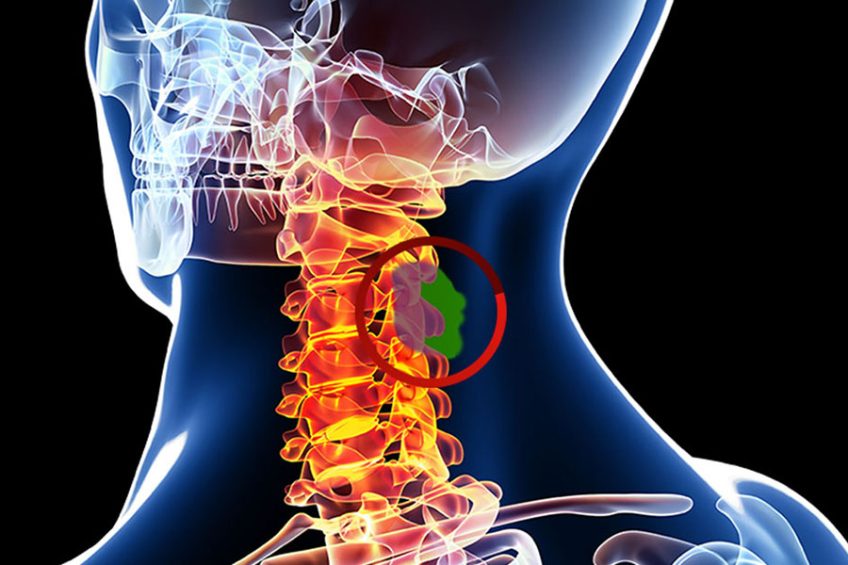A spinal tumor is a mass of abnormal tissue that develops in the spine, either in the spinal cord (spinal cord tumors) or in the vertebrae (vertebral tumor or extradural tumor). The cells that make up the tumor are abnormal cells, which grow outside the usual mechanisms of cell growth control. Spinal tumors can cause pain, neurological problems and sometimes paralysis.
A spinal tumor can be life-threatening and can cause permanent disability. Treatment of spinal tumors may include surgery, radiation therapy, chemotherapy and other medications, most often combinations of these. Evidence indicates surgical resection of spinal cord tumors as the gold standard in the treatment of these conditions, chemotherapy and radiation being used for tumors with a high degree of infiltration into neighboring tissues or for recurrent tumors.
They can be malignant tumors (cancerous) or benign tumors (non-cancerous) that can develop in the spinal cord or surrounding areas. A malignant spinal tumor contains cancer cells, grows rapidly, invades nearby healthy tissues and can be life-threatening.
A benign tumor does not contain cancer cells, rarely invades nearby tissues or spreads to other parts of the body and usually does not grow again after it is removed. However, even if some such tumors are not cancerous, they can compress the spinal cord or nerve roots and cause symptoms. Some common benign spinal tumors are osteoma, osteoblastoma, hemangioma, neurofibroma, and osteochondroma. Fortunately, spinal tumors are relatively rare.
CONTENT:
Causes
The exact cause of spinal tumors is unknown. It is suspected that certain defective genes are involved, but it is not known whether such genetic defects are inherited or simply develop over time. These could be caused by environmental factors, such as exposure to certain chemicals.
However, in some cases, spinal tumors are linked to known inherited syndromes, such as neurofibromatosis 2 and von Hippel-Lindau disease.
Symptoms
Because spinal tumors can affect the spinal cord or nerve roots, blood vessels, or vertebrae, the symptoms are different and occur especially as the tumors grow. Possible signs and symptoms include:
- Pain at the site of the tumor due to its growth
- Back pain, which often radiates to other parts of the body
- Lack of sensitivity to pain, heat or cold
- Fecal or urinary incontinence
- The weight of walking, which sometimes leads to falls
- Back pain that gets worse at night
- Loss of sensitivity or muscle weakness, especially in the arms or legs
- Muscle weakness, which can be moderate or severe, in different parts of the body.
- Back pain is an early symptom of spinal tumors. The pain can spread to the hips, legs, soles or arms and can worsen over time – even with treatment.
Spinal tumors have varying degrees of evolution, depending on the type of tumor.
Vertebral tumors can weaken bone structure, predisposing the spine to fractures due to minor trauma.
Treatment
The goal of treatment is to reduce or prevent nerve damage caused by pressure on the spinal cord. The faster the symptoms develop, the faster treatment is needed to prevent permanent damage.
Ideally, the goal of treatment is to completely remove the tumor, but this goal can be complicated by the risk of permanent damage to the spinal cord and surrounding nerves. Physicians must also take into account age and general health. Corticosteroids (dexamethasone) can be given to reduce inflammation and swelling around the spinal cord.
Emergency surgery may be needed to improve spinal cord compression. Some tumors can be completely removed. In other cases, only part of the tumor can be removed to relieve pressure on the spinal cord. Chemotherapy has not been shown to be effective against most primary tumors, but may be recommended in some cases, depending on the type of tumor.
The type of non-surgical treatment depends on many factors, including the type of tumor (benign or malignant), the stage of the disease, the goal of treatment (eg, pain reduction, healing), the patient’s life expectancy, and general health.
Surgery
It may be recommended to remove the tumor if it is limited to only a portion of the spine. During surgery, there may be a risk of damage to nearby nerves or the spinal cord. Surgical resection can be combined with radiation or chemotherapy to remove residual cancer cells.
Surgery to treat a spinal tumor may be warranted when a specific biopsy is needed, if the tumor causes compression of the spinal cord or nerves, if the neurological deficit progresses, the pain does not respond to non-surgical treatment, we are talking about the destruction of the vertebrae or develops spinal instability.
But even with the latest technological advances in surgery, not all tumors can be completely removed. When the tumor cannot be completely removed, surgery may be followed by radiation or chemotherapy. Recovery after surgery on the spine can take weeks or even longer, depending on the procedure. There may be a temporary loss of sensation or other complications, including bleeding and nerve tissue damage.
Radiotherapy
It is done either after surgery for spinal cancer or alternatively to treat spinal cancer that is not operable.
Chemotherapy
One or more anti-cancer drugs are given to kill the tumors. Some of the commonly used drugs are methotrexate, doxorubicin, cyclophosphamide, carboplatin, ifosfamide. These drugs are given either orally, injected intravenously or intramuscularly, or injected directly into the affected area (including injection into the cerebrospinal fluid if the tumor affects the spinal cord or spinal nerves).
Palliative therapy
Pain therapy is also called palliative treatment – the goal is to relieve pain, reduce symptoms and prevent complications. These are treatments that do not cure the disease, but rather improve the patient’s quality of life. Treatment may include anti-inflammatory drugs and various forms of treatment for pain, including morphine. Physical therapy may be prescribed to help a patient regain flexibility and muscle strength. In addition, your doctor may recommend nutritional support.


